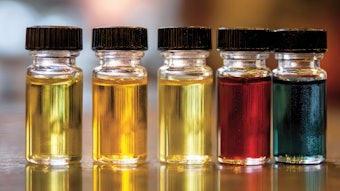
So, I am making a bit of a left turn here and reporting to you all from Flavorcon 2023. The impressions that we have gathered are from the attendees at the Master Class.
Read this article in page view in the Perfumer & Flavorist+ January 2024 Digital Edition.
Petitgrian oil, organic
Source: OQEMA
FEMA# N/A, CAS# 72968-50-4
Odor @ 1%: Dry, woody, floral, green, ‘astringent’, fresh, herbal, orange tree, similar to bergamot, terpenic, very bright, crisp, spicy, seedy, reminds us of baklava made with orange blossom honey. Bell pepper note under the floral.
Taste @ 1ppm: Floral, dry, woody, slightly astringent, black or Earl Grey tea, bell pepper, “carbonation”.
Usages: This would be very interesting as a point of differentiation in a bell pepper for special brightness. This panel found that this would work nicely in bitters like Campari. They also found uses in yuzu, grapefruit, prickly pear, apricot, peach, plum and pear for the crisp skin note. We also thought of lemongrass, cola, sarsaparilla, ginger ale, and for one of my favorites: gin. If we think of more unusual profiles, we find this might be great in aloe, cactus and prickly pear. And lastly, reigning it back in to the more ordinary, I think we could make a beautifully differentiated orange profile but just add a touch!
Phellandrene, ex. Dives
Source: Berjé
FEMA# 2856, CAS# 4221-98-1, 99-83-2
Naturally occurring: Apricot, black currant, nutmeg, schinus mole, capsicum, caraway, cardamom, carrot, celery, Gruyere, cinnamon, citrus, coriander, cumin, curry, date, dill, eucalyptus, fennel, gin, ginger, honey, hops, laurel, lychee, lovage, mace, peppermint, pennyroyal, spearmint, mushroom, nectarine, nutmeg, oregano, papaya, parsley, passionfruit, pecan, black pepper, pistachio, pomegranate, pork, rosemary, sage, strawberry, tea, thyme, tomato, marjoram, white wine.
Odor @ 1%: Green, zesty, fresh, bright, bitters, camphoraceous, cherry, black pepper, slightly sweet, lemon, lime, key lime, mint, woody, nutmeg, coriander.
Taste @ 3ppm: Lime, curry, lemon, terpenic, warm, fresh, spicy, woody, nutmeg, coriander.
Possible applications: I have to admit that Berje’ got me here on the source of this material. I was not familiar with eucalyptus dives. So, now I know that this is a tree endemic to southeast Australia commonly referred to as broad-leaved peppermint or blue peppermint. But, note that it’s a tree and not like mentha piperita here in the United States. So, this panel liked this for lime, orange, lemon (lemon curd), cardamon, mango, guava, passionfruit, cola, mojito, sage, thyme, curry, Thai basil, where it is a bit more spicy and has a little more bite. And don’t forget about that extended list of where found!
 Peter Wynn Thompson
Peter Wynn Thompson
Phenethyl acetate, natural
Source: Avant
FEMA# 2857, CAS# 103-45-7
Naturally occurring: Apple, banana, beer, black current, blue cheese, bread dough, cheddar, camembert, gruyere, mozzarella, cherry, cinnamon, cloves, cocoa, date, fig, grape, guava, honey, lychee, malt, muskmelon, papaya, pear, pineapple, plum, pomegranate, olive, passionfruit, rooibos, sake, sherry, starfruit, strawberry, tea, tequila, tomato, vanilla, whiskey, wheat bread, wine.
Odor @ 1%: Floral, green, sweet, slightly fatty, mushroom, honey, powdery, berry, talcum-like, fermented, yeasty and licorice on dry out.
Taste @ 2 ppm: Pulpy, floral, sweet, green, berry, actual petals.
Possible applications: This is a really lovely clean source of phenethyl acetate. The panel thought that this would work well in beer, sherry sweet wines and champagne profiles. Thinking of fruits, we thought of peach, plum, cherry, all berries, lychee and adult grape profiles. Please also include honeydew, cantaloupe, and watermelon for your consideration. I think that this would be extra in a Kiwi profile to help cut the harsh green notes. There was a call out for mangosteen because it’s floral, sweet and nectar-like. We also thought of fun things like petal notes with some mentions of elderflower. We can’t forget the typical places where this is used like honey, chocolate and fermented things, bread, yeast, and a call out for saltwater taffy! One panelist thought of coffee bean top-notes and there were a few calls for seared beef and button mushrooms.
Pyrazine Mix #10, natural
Source: Excellentia
FEMA# N/A, CAS# N/A
Odor @ 1%: Nutty, dry, brown, soft, hazelnut, raw bean sprouts, chocolate, creamy (macadamia), peanut butter, baked potato jacket, sweet yam, and cognac, oily and then seafood (crustacean) on the dry out.
Taste @ 3ppm: Toasted, brown, soft, nutty, oily.
Possible applications: The panel found this to be useful in chocolate, cocoa, peanut butter, Nutella, pie crust, graham crackers, coffee, toffee, bread flavors, and seared beef. One panelist thought this would work very well in high-malt beer. I am a big fan of pyrazines as a family of compounds and find most of them to be just beautiful! I think this particular blend would work very well in bakery, cereal, pretzel, or toast notes. If I think of browned butter, I also come to caramel, butterscotch and toffee. This is great for so many nuts like cashew, pecan, peanut, hazelnut. I’d be tempted to add to give jammy notes at super low levels. I’d play with this in crab profiles as well in a heartbeat.
2-(trans-2-pentenyl)cyclopentanone
Source: Bedoukian
FEMA# 4284, CAS# 51608-18-5
Not naturally occurring.
Odor @ 1%: Creamy, green, slight licorice, floral, blue cheese leather.
Taste @ 1ppm: Creamy, dairy, eggy, fatty, lactonic, melon, condensed milk, celery, green, slightly floral, vegetative, rhubarb, cooked mushroom, cooked milk, coconut, and blue cheese. On the dry out, one panelist found beanie flavor.
Possible applications: So, this fun compound is called Jasminone B by Bedoukian. As you can see, this carries some creamy notes and some green notes that would lend it to a variety of profiles. If I wander through the creamy aspects of this I think of whipped cream, ice cream, butter, milk, cooked milk, coconut, custard, cheesecake and also egg flavors. The panel also liked this for rhubarb, mushroom, celery, veggies and parmesan and blue cheese. I also see a caraway seed note and would try in rye bread and maybe also a chicken profile. Maybe spearmint as well. One panelist noted that this is as if a ketone and lactone had a synthetic baby!
 Peter Wynn Thompson
Peter Wynn Thompson
4,5-dimethyl-2-isobutyl thiazole
Source: Millipore Sigma
FEMA# 4647, CAS# 53498-32-1
Naturally occurring: Red beans, sheep liver, boiled potatoes, French fries, shrimp.
Odor @ 0.1%: Dark, leafy, woody, spicy, botanical, cooked vegetables, floral, rubbery, spicy, jalapeno, black currant, peppery, and more thiazole on the dry-out.
Taste @ 0.1ppm: Slightly astringent, vegetative, leafy, woody, botanical.
Possible applications: Millipore Sigma calls this compound geranium thiazole. I have not had many (or any) sheep liver requests but if I did I would use this. But it’s also a good thing that we thought of several other applications here. This compound is firmly entrenched in the savory category. The panel thought of black currant, black pepper, celery, dill pickle, red and black beans, tamale, roast corn, potatoes, rosemary, savory, cooked vegetables such as broccoli, Thai and jalapeno peppers, and potentially peanut.
I hope you enjoyed this slightly different take on the Flavor Report!










